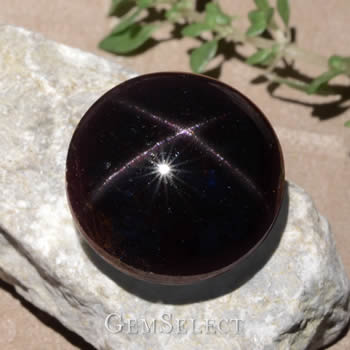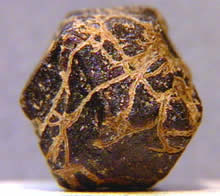Unusual Star Garnet: A Rare Gemstone with a Stellar Effect
Introduction to Star Garnet
Star garnet is a captivating and rare variety of garnet that exhibits a unique optical phenomenon known as asterism. This star-like effect, caused by the reflection of light off inclusions within the gem, makes star garnet a sought-after gemstone for collectors and enthusiasts. Unlike more common garnets, star garnets are distinguished by their deep colors and the striking star pattern that appears under proper lighting. For more details, explore the Garnet Buying Guide or learn about Garnet Meaning and Powers.
What is Asterism?
Asterism is the star-shaped optical effect seen in certain gemstones when light reflects off inclusions, typically rutile needles, arranged in a specific pattern. In star garnets, these inclusions create a four-rayed or, more rarely, a six-rayed star. This phenomenon is most commonly associated with star sapphires and star rubies, but star garnets, along with other gems like moonstone, quartz, spinel, citrine, diopside, emerald, chrysoberyl, and beryl, can also display this effect, though such specimens are exceptionally rare. To learn more about garnets in general, visit All About Garnet.
Characteristics of Star Garnet
Star garnets are typically opaque and display deep brownish-red or reddish-black hues. The garnet varieties that exhibit asterism are primarily almandine or a blend of almandine and pyrope garnet. The star effect in these gems is caused by rutile inclusions, which must be precisely aligned to reflect light in a mult-rayed star pattern. The quality and visibility of the star depend on the cut of the gemstone, often fashioned as cabochons, and the lighting conditions under which it is viewed. For insights into other rare garnets, see Rare Garnets.
Physical and Chemical Properties
- Composition: Star garnets are silicates, with almandine (iron aluminum silicate) and pyrope (magnesium aluminum silicate) being the primary types.
- Hardness: Garnets rank 6.5 to 7.5 on the Mohs scale, making them durable for jewelry use.
- Color: Deep red to reddish-black, often opaque.
- Optical Effect: Asterism, with four or six rays depending on the alignment of rutile inclusions.

Where Are Star Garnets Found?
Star garnets are extraordinarily rare and have only been discovered in two locations worldwide: Idaho, USA, and India. In the United States, Northern Idaho - specifically the region northeast of Moscow and southeast of Coeur d'Alene - is a significant source. The rarity and beauty of star garnets have led Idaho to designate them as the state gemstone, a source of pride for local communities. In India, star garnets are also found, but they are less documented, and their quality varies compared to Idaho specimens.
Mining in Idaho
Mining for star garnets in Idaho is often done in alluvial deposits, where garnets are extracted from riverbeds and gravel. The process is labor-intensive, and the yield of gem-quality star garnets is low, contributing to their exclusivity. Some mining sites in Idaho allow visitors to dig for their own garnets, offering a unique opportunity to experience the thrill of gem hunting.
The Star Effect: How to View It
The star effect in star garnets is subtle and requires specific conditions for optimal visibility. Direct sunlight or a focused light source, such as a narrow-beam halogen spotlight or a small flashlight, is ideal. To observe the star pattern:
- Position yourself directly above the gemstone.
- Look straight down while illuminating the stone with a concentrated light source.
- Rotate the gem slightly to catch the star effect as the light reflects off the rutile inclusions.
Most star garnets display a four-rayed star, but six-rayed stars, though exceedingly rare, are occasionally seen. Some gem dealers claim that six-rayed stars are exclusive to Idaho star garnets, but this is difficult to verify due to the scarcity of such specimens.

Cultural and Historical Significance
In Idaho, star garnets hold a special place in local culture. Their designation as the state gemstone reflects their importance to the region’s identity and economy. Historically, garnets have been valued for their durability and rich colors, often used in jewelry and decorative items across cultures. The star effect adds an additional layer of allure, making star garnets a symbol of rarity and natural beauty.
Uses of Star Garnet
Star garnets are primarily used in jewelry, particularly in rings, pendants, and brooches, where their unique star effect can be showcased. Due to their opacity, they are typically cut as cabochons to enhance the visibility of the asterism. Collectors also prize star garnets for their rarity and the challenge of finding high-quality specimens with a clear star effect.
Care and Maintenance
To maintain the beauty of star garnet jewelry:
- Cleaning: Use warm soapy water and a soft brush to clean star garnets. Avoid harsh chemicals or ultrasonic cleaners, which may damage the gem.
- Storage: Store star garnets separately from other gemstones to prevent scratches, as their hardness can vary slightly.
- Handling: Handle with care to avoid chipping, especially in jewelry settings where the gem is exposed.
Frequently Asked Questions About Star Garnet
What is a star garnet?
A star garnet is a rare variety of garnet that exhibits asterism, a star-shaped optical effect caused by light reflecting off rutile inclusions. It is typically opaque and deep red or reddish-black in color.
Where are star garnets found?
Star garnets have only been found in two places: Northern Idaho, USA, and India. In Idaho, they are mined in areas northeast of Moscow and southeast of Coeur d'Alene.
What causes the star effect in star garnets?
The star effect, or asterism, is caused by inclusions of rutile needles within the garnet. These needles must be aligned to reflect light in a pattern that forms a four- or six-rayed star.
How can I best view the star effect in a star garnet?
To view the star effect, use direct sunlight or a focused light source like a flashlight. Position yourself directly above the gem and look straight down, rotating the stone slightly to catch the star pattern.
Are six-rayed star garnets more valuable than four-rayed ones?
Six-rayed star garnets are rarer than four-rayed ones, which can make them more valuable to collectors. However, value also depends on the clarity of the star effect and the overall quality of the gem.

